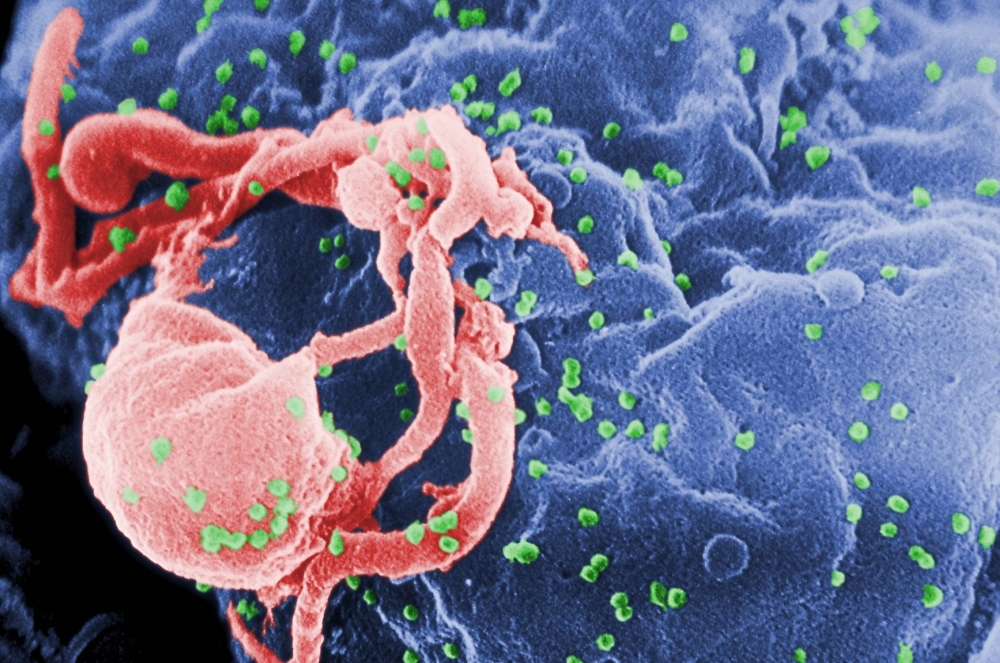
Human immunodeficiency virus-1 (HIV-1) virions (spherical in appearance) bud from a cultured human lymphocytes in this scanning electron microscopic image obtained from Centers for Disease Control and Prevention in Atlanta, Georgia, in 2019. |
CDC / Handout / via REUTERS
By Pauline CURTET
AFP-JIJI
Jul 29, 2024
Munich, Germany –
Three people effectively cured of HIV have spoken about how a risky transplant procedure saved their lives, with one saying they are "living proof" of hope in the fight against the virus.
The trio spoke about their experience at the International AIDS Conference in Munich, which has gathered experts, researchers and activists to discuss developments in the HIV epidemic.
Only seven people are considered to have been effectively cured after receiving a stem cell transplant, a painful and risky procedure only suitable for patients who have both HIV and aggressive leukaemia.
Adam Castillejo, a 44-year-old also known as the "London patient," said it took "years" to be sure his transplant had produced the desired effect.
"There is not a specific time when you say: 'You're cured,' it takes a while, and then you have controlled expectations toward that."
Only once doctors are sure that the patients' HIV will not return do they stop treatment with antiretroviral drugs, which reduce the amount of the virus in the blood.
Marc Franke, 55 — the "Duesseldorf patient" — also experienced the painstaking process.
"The doctors did so many tests to really be 100% sure before the antiretroviral therapy was discontinued," Franke said.
The bone marrow transplant, which carries a 10% risk of death, essentially replaces a person's immune system.
Pointing to the "enormous" mortality rate and other complications, Franke went so far as to say: "I can't recommend it to anyone."
Despite having "lost several years" to leukaemia, Franke said in retrospect he "would have preferred to take one tablet a day" of antiretrovirals than to have gone through the grueling transplant process.
Inspiring 'new directions'
Earlier this month, doctors announced the number of people effectively cured from HIV had reached seven.
The seventh — dubbed the "next Berlin patient" — received a bone marrow transplant for his leukaemia in 2015 and stopped taking antiretroviral drugs in late 2018.
Medical researchers said he now appears to be both HIV and cancer free.
Sharon Lewin, president of the International AIDS Society, called the cases "really exciting" but admitted that the therapy was only applicable to a very small number of people.
The procedure had effectively cured just "seven people out of 40 million people living with HIV," Lewin said. "These are very rare cases, but they inspire new directions in science."
All but one of the seven patients received stem cells from donors who had a rare gene mutation that effectively makes people immune to HIV.
Paul Edmonds is in his late sixties and was the third patient who spoke about his experiences at the conference.
He agreed that "the stem cell transplant is not for everyone because there's so many risks involved."
However Edmonds said his and his fellow patients' experience gave "hope ... that a cure is possible because we're living proof that it can happen."
There were 1.3 million new HIV infections last year, while 39 million people are living with the virus, according to the World Health Organization.
Timothy Ray Brown — the original "Berlin patient" — was the first person declared cured of HIV back in 2008.
Brown died from cancer in 2020.
No comments:
Post a Comment